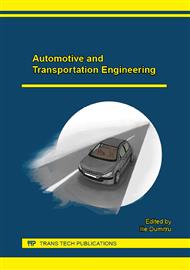p.418
p.429
p.437
p.443
p.455
p.461
p.472
p.480
p.491
Adaptive Traffic Signal Control on a National Road Intersection
Abstract:
Adaptive traffic signal control is the process by which the timing of a traffic signal is continuously adjusted based on the changing arrival patterns of vehicles at an intersection, usually with the goal of optimizing a given measure of effectiveness. In this paper a traffic signal program is developed in which the characteristics of a traffic signal cycle are optimized at the conclusion of every phase based on the arrival times of vehicles to an intersection, using stopped delay as the measure of effectiveness. The methodology which leads to the signal plan is shown to provide improvement in performance for a number of intersection configurations and traffic regimes over traditional forms of traffic signal control.
Info:
Periodical:
Pages:
455-460
Citation:
Online since:
January 2016
Authors:
Price:
Сopyright:
© 2016 Trans Tech Publications Ltd. All Rights Reserved
Share:
Citation:


